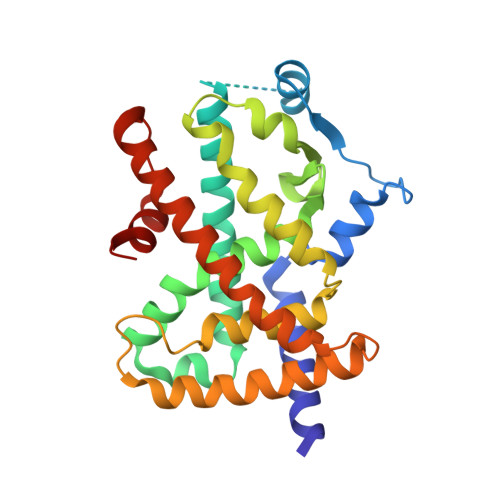Structural Basis of Altered Potency and Efficacy Displayed by a Major in Vivo Metabolite of the Antidiabetic PPAR gamma Drug Pioglitazone.
Mosure, S.A., Shang, J., Eberhardt, J., Brust, R., Zheng, J., Griffin, P.R., Forli, S., Kojetin, D.J.(2019) J Med Chem 62: 2008-2023
- PubMed: 30676741
- DOI: https://doi.org/10.1021/acs.jmedchem.8b01573
- Primary Citation of Related Structures:
6DHA - PubMed Abstract:
Pioglitazone (Pio) is a Food and Drug Administration-approved drug for type-2 diabetes that binds and activates the nuclear receptor peroxisome proliferator-activated receptor γ (PPARγ), yet it remains unclear how in vivo Pio metabolites affect PPARγ structure and function. Here, we present a structure-function comparison of Pio and its most abundant in vivo metabolite, 1-hydroxypioglitazone (PioOH). PioOH displayed a lower binding affinity and reduced potency in co-regulator recruitment assays. X-ray crystallography and molecular docking analysis of PioOH-bound PPARγ ligand-binding domain revealed an altered hydrogen bonding network, including the formation of water-mediated bonds, which could underlie its altered biochemical phenotype. NMR spectroscopy and hydrogen/deuterium exchange mass spectrometry analysis coupled to activity assays revealed that PioOH better stabilizes the PPARγ activation function-2 (AF-2) co-activator binding surface and better enhances co-activator binding, affording slightly better transcriptional efficacy. These results indicating that Pio hydroxylation affects its potency and efficacy as a PPARγ agonist contributes to our understanding of PPARγ-drug metabolite interactions.
- Department of Integrative Structural and Computational Biology , The Scripps Research Institute , La Jolla , California 92037 , United States.
Organizational Affiliation:


















